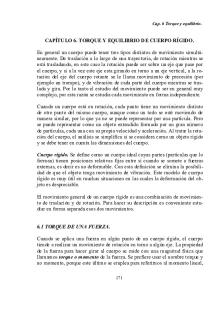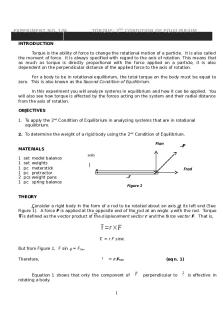Torque equilibrium - Grade: A PDF

| Title | Torque equilibrium - Grade: A |
|---|---|
| Author | Austin Glass |
| Course | Physics I |
| Institution | Saint Louis University |
| Pages | 4 |
| File Size | 159.4 KB |
| File Type | |
| Total Downloads | 26 |
| Total Views | 150 |
Summary
Lab experiment with calculations and data on torque equilibrium....
Description
Torque Equilibrium Austin Glass (lab partner: Jack McElligott) 3/22/17 ABSTRACT Torque is the tendency of a force to cause rotation. When the forces applied to a body sum to zero, the body is in equilibrium. In the experiment performed, the concept of torque and equilibrium were studied through the use of a meter stick and various fulcrums being put into equilibrium with varying weights. The experiment calculated the percent difference between computed and experimental values as error analysis. The percent differences for part 1 were 1.61% and 11.58%, 5.12% for part 2, and 3.15% for part 3. The experiment was likely to agree with the equilibrium theory since the percent differences were generally low and the values were similar. THEORY Torque is the tendency of a force to produce rotation. Torque is defined as the product of the force and the distance from which the action is applied. If several forces act on a rigid, extended body, and the body is in equilibrium, then the net force must be zero and the net torque must also be zero. This can be shown mathematically to demonstrate the first and second conditions of equilibrium.
Torque is typically calculated by whichever axis is the most convenient, since it may be computed about any axis. This experiment will use parallel vertical forces, so the necessary equations are (1b) and (2). OBJECTIVE The purpose of this lab is to study the equilibrium of a rigid body that is extended with respect to rotation. PROCEDURE In part 1, a meter stick was weighed. The meter stick was clamped to a balancing holder and then put into a support base. The meter stick was balanced horizontally and the position was recorded. A weight holder was placed at the 30cm mark and 200g were hung from it. Another weight holder was placed with 100g and was moved about until the meter stick balanced horizontally; the position was recorded. The computational and experimental values for the horizontal position were compared by percent difference. A measurement of torque was taken with an arbitrary point 0.3m from the meter stick in its plane of rotation. An extra meter stick and a protractor were used to determine the measurements. For part 2 the balancing holder was set at the 25cm mark of the meter stick. 200g were placed on the meter stick so that it balanced horizontally; position was recorded. The weight was computed and compared to that obtained in part 1. For part three the
balance holder was set to the 40cm mark and 200g were set at the 20cm mark. An object of unknown weight was put on another holder and adjusted the position on the meter stick until a horizontal balance was achieved; position was recorded. The object was massed. Weight was then derived and computed and then compared to the actual value. DATA
Position (cm) Angle (o) R (cm)
Position (cm)
Position (cm)
Part 1 Mass (100g) Mass (200g) Fulcrum 81.1 30.0 50.0 48.8 53.0 10.2 38.7 41.1 31.0 Part 2 Fulcrum Mass (200g) 25.0 12.2 Part 3 Fulcrum Mass (200g) Mass (unknown) 40.0 20.0 55.1
CALCULATIONS F=mg
(0.271kg)*9.8m/s/s)=2.66N
Στ = 0 = X1 = (F2X2)/ F1
(2.66N*20.0cm)/1.68N =31.6cm
R1= (R2F2sinθ2 - RmFmsinθm - RFFFsinθF) / (F1sinθ1) =Στ (41.1 cm∗2.657 N∗sin (53))−(31 cm∗−1.93 N∗sin (10.2))−(31 cm∗1.93 N∗sin(190.2)) (1.68 N∗sin ( 48.8 )) =34.7cm
Percent difference=
|Experimental Value−Computed Value| Experimental Value
|31.1 cm−31.6 cm| 31.1 cm Στ = 0 =FX - FmXcm
* 100%
*100% =1.61% (2.66N*12.2cm)/(25cm)=1.30N
QUALITATIVE ERROR ANALYSIS
Possible points of error for this experiment were the balancing of the ruler and the measurement of angles. The procedure required the ruler to balance horizontally. The ruler was supposed to be completely horizontal; however, the ruler would sometimes balance with a slight tilt, or over time it would begin to tilt in a direction. The measurement of angles was difficult because it required a ruler and protractor to be held steadily at a certain point. Since these objects were held in such a way as to not disturb the ruler’s equilibrium, they were not completely steadied. This movement from the measurement devices may have led to inaccurate readings. QUANTITATIVE ERROR ANALYSIS For this experiment various values were recorded experimentally and then computed to find their theoretical values. For part 1 of the experiment the percent difference between the computed and experimental position of the 100g mass was 1.61% for section (a) and 11.58% for section (b). Parts 2 and 3 computed weight/force for the meter stick and an unknown mass. For part 2, the values differed by 5.12%. For part 3 the values of the unknown masses weight differed by 3.15%. RESULTS Part 1 (a) Force Mass 2 (N) 2.66 Force Mass 1 (N) 1.68 Computed Position (cm) 31.6 Percent Difference (%) 1.61 Part 1 (b) Computed Position by Arbitrary Point (cm) Percent Difference (%) Part 2 Force Meter Stick (N) Computed Force (N) Percent Difference (%)
1.37 1.30 5.12
Part 3 Force Unknown (N) Computed Force (N) Percent Difference (%)
3.41 3.52 3.15
34.68 11.58
CONCLUSION Torque is defined as the product of the force and the distance from which the action is applied, so the point at which is defined as the point of rotation is arbitrary. The chosen point, wherever it is, should yield the same results. This experiment demonstrated this by offering two different points to form the calculations about in part 1. The computed positions were only 1.61% and 11.58% different from the experimental position determined. The first computation was under 5%, so it
would support the extended equilibrium theory. However, the second computed value at a point about 30cm above the meter stick yielded a much higher percent difference, so it would fail to support the theory. Since the second part required much more measurements that were difficult to measure precisely, that may have caused rise to the discrepancy. The experiment tested torque equilibrium. The values of a torque equilibrium equation should arrive at zero if the object is in extended equilibrium. This should not matter at what point one sets as the axis of rotation. The experiment also computed theoretical downward gravitational forces—weights—of different objects within the equilibrium system. Part two demonstrated the experimental and computed values to be 5.12% different and in part 3 the values were only 3.15% different. Since no in depth error analysis was made for the experiment, one cannot make a definitive statement; however, the computed values were all relatively close to those experimental values from the lab. It is likely that the experiment supports the extended equilibrium theory....
Similar Free PDFs

Torque equilibrium - Grade: A
- 4 Pages

Inertia and torque - Grade: A
- 5 Pages

Equilibrium of a Rigid Body
- 4 Pages

Rotation and Torque
- 1 Pages

Fuerza y torque electromagnetico
- 9 Pages

Torque - Nota: 9
- 7 Pages

Torque worksheet-2 - Lab
- 4 Pages

Experiencia N°12 Torque
- 3 Pages

A child - Grade: A
- 5 Pages

Torque y equilibrio
- 22 Pages

Torsi (torque) Pada Motor
- 15 Pages

Problemas Resueltos DE Torque
- 4 Pages

Equilibrium notes
- 6 Pages

Solubility Equilibrium
- 8 Pages
Popular Institutions
- Tinajero National High School - Annex
- Politeknik Caltex Riau
- Yokohama City University
- SGT University
- University of Al-Qadisiyah
- Divine Word College of Vigan
- Techniek College Rotterdam
- Universidade de Santiago
- Universiti Teknologi MARA Cawangan Johor Kampus Pasir Gudang
- Poltekkes Kemenkes Yogyakarta
- Baguio City National High School
- Colegio san marcos
- preparatoria uno
- Centro de Bachillerato Tecnológico Industrial y de Servicios No. 107
- Dalian Maritime University
- Quang Trung Secondary School
- Colegio Tecnológico en Informática
- Corporación Regional de Educación Superior
- Grupo CEDVA
- Dar Al Uloom University
- Centro de Estudios Preuniversitarios de la Universidad Nacional de Ingeniería
- 上智大学
- Aakash International School, Nuna Majara
- San Felipe Neri Catholic School
- Kang Chiao International School - New Taipei City
- Misamis Occidental National High School
- Institución Educativa Escuela Normal Juan Ladrilleros
- Kolehiyo ng Pantukan
- Batanes State College
- Instituto Continental
- Sekolah Menengah Kejuruan Kesehatan Kaltara (Tarakan)
- Colegio de La Inmaculada Concepcion - Cebu

